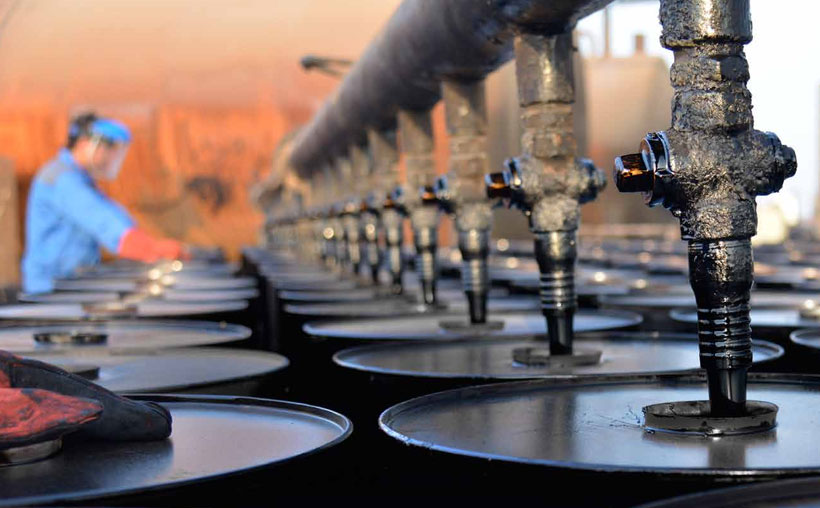OUR SOURCE ARE
Bitumen Refineries
We acquire Bulk Bitumen in Vessels with volumes comprising around 30,000 Metric Tons each Cargo directly from Bitumen Manufacturers either they are Bitumen Refineries (VB Based) or State of the Art Oil Refinery. Being financially competitive in manufacturing market means meeting deadlines and constantly striving to Increase Production, Reduce Downtime and Maintain Product Quality. Our Buyers are Bulk Consumers of Bitumen like Construction and Infrastructure Development Companies, Importers of Bitumen willing to supply locally in their countries.
Mainly, Our Buyers are Bulk Consumers of Bitumen like Construction and Infrastructure Development Companies, Importers of Bitumen willing to supply locally in their countries. We have 20 Years of Asphalt/Tar/Bitumen and Cement Export history.


Overview of Refined Bitumen
Bitumen is an Oil Based substance. It is a Semi-Solid Hydrocarbon Product produced by removing the Lighter Fractions (such as Liquid Petroleum Gas, Petrol and Diesel) from Heavy Crude Oil during the Refining process. As such, it is correctly known as Refined Bitumen.
The vast majority of Refined Bitumen is used in Construction: primarily as a constituent of products used in paving and roofing applications. According to the requirements of the end use Bitumen is produced to specification. This is achieved either by refining process or blending.
It is estimated that the current world use of Bitumen is approximately 102 million tons per year. Approximately 85% of all the Bitumen produced is used as the Binder in Asphalt for roads. It is also used in other paved areas such as Airport Runways, Car Parks and Footways.
Overview of Refined Bitumen
Bitumen is an Oil Based substance. It is a Semi-Solid Hydrocarbon Product produced by removing the Lighter Fractions (such as Liquid Petroleum Gas, Petrol and Diesel) from Heavy Crude Oil during the Refining process. As such, it is correctly known as Refined Bitumen.
The vast majority of Refined Bitumen is used in Construction: primarily as a constituent of products used in paving and roofing applications. According to the requirements of the end use Bitumen is produced to specification. This is achieved either by refining process or blending.
It is estimated that the current world use of Bitumen is approximately 102 million tons per year. Approximately 85% of all the Bitumen produced is used as the Binder in Asphalt for roads. It is also used in other paved areas such as Airport Runways, Car Parks and Footways.

Bitumen Refining Process
Residues from the Distillation of meticulously selected crude oils provide the base materials for Bitumen Production. Bitumen refining separates the lighter fractions from the residues. Several manufacturing methods are used to produce Specification Bitumen depending on the crude source and processing capabilities available. Often a combination of processes is selected.

Distillation
The most common Refining Process is straight reduction from crude or a crude blend, using atmospheric and vacuum distillation. In the diagram, atmospheric distillation used to separate lighter petrochemical and fuel fractions from the non-boiling component at the bottom, known as an atmospheric residue. The lighter fractions, such as Gas oil and Fuel oils are fed to other refinery units. The atmospheric residue is retained for bitumen. To remove the last traces of the lighter fractions and avoid heat transformation of the molecules. The atmospheric residue introduced into a vacuum distillation unit, here the pressure reduction lowers boiling temperatures and unwanted thermal cracking of the molecules can be avoided.
Solvent De-Asphalting
Specific solvents can also be used to separate the Lubricant and Bitumen components of Crude, without damaging their chemical structure. According to the solvent used – propane or butane – different Categories of Bitumen can be obtained. Along with finely controlled variations in the vacuum distillation process, these processes permit the Production of Bitumen with varying levels of penetration. This property and the softening point are the two fundamental defining characteristics of bitumen produced to engineering specifications. Further key physical properties are sensitivity to temperature and ageing, cohesion and elasticity, all of which are measured by precise tests.
Oxidation
Bitumen can be further processed by blowing air through it at elevated temperatures (280°C on average) to alter its physical properties for commercial applications.
Oxidized Bitumen covers two distinct types depending on the degree of oxidation: air rectified and oxidized. Oxidized bitumen has a distinctive consistency at room temperature and a rubbery nature which affects how it responds to stress, or imprint. The process of oxidation increases the stiffness and softening point of the bitumen and considerably alters key physical properties. Varying the length of the oxidation or air blowing process varies the extent of the reaction and produces distinctive end products. Oxidized Bitumen is used in roofing applications, while air rectified bitumen used in paving applications and some roofing applications.
Blending
The final Bitumen Product can be produced to technical specification either directly in the refining process or by blending bitumen with different physical properties. Blending of higher and lower viscosity residues in the required proportions may take place at the refinery, at terminals or at a third party facility, where blend components and finished products can be easily transported and distributed for use.


